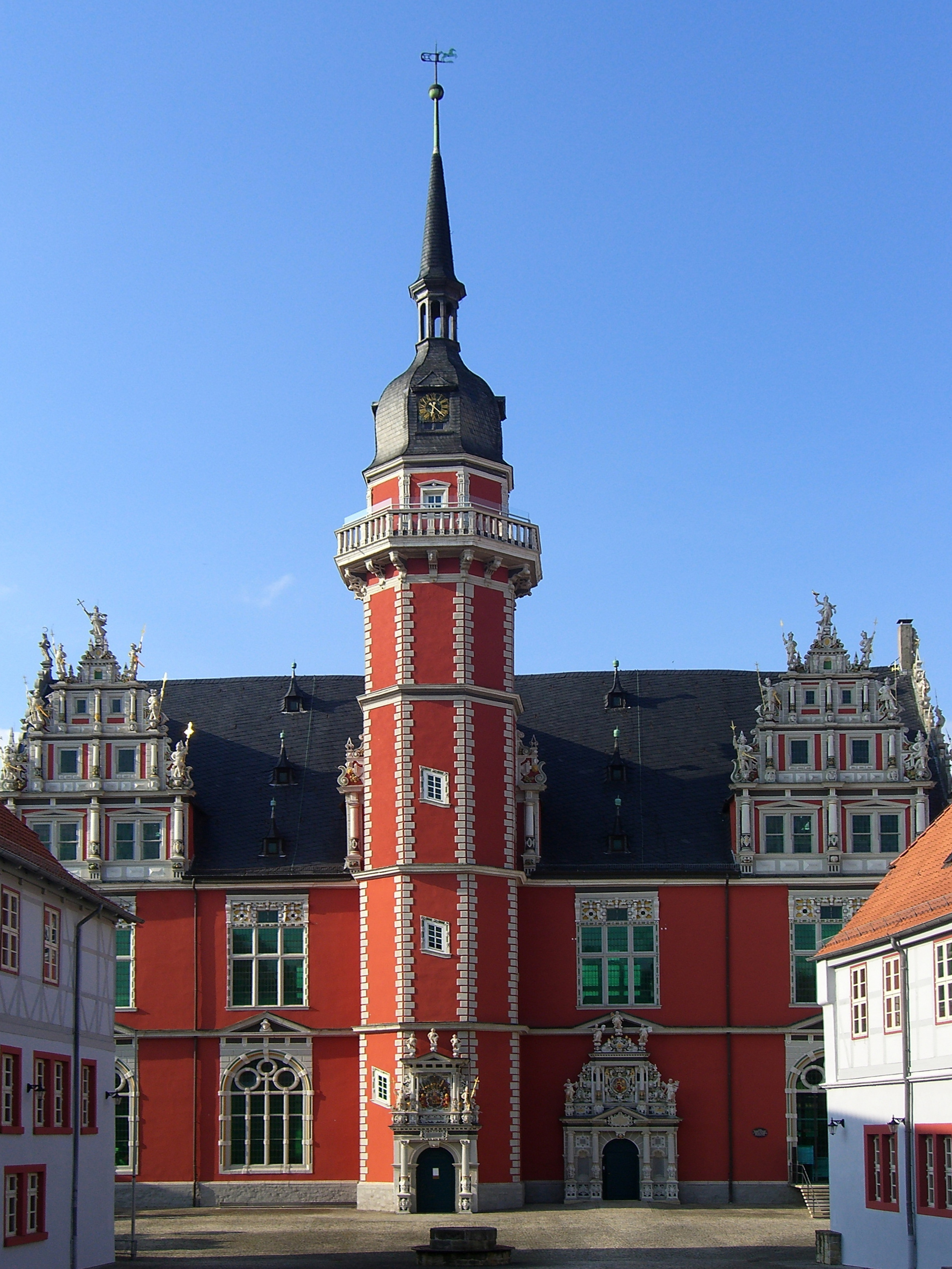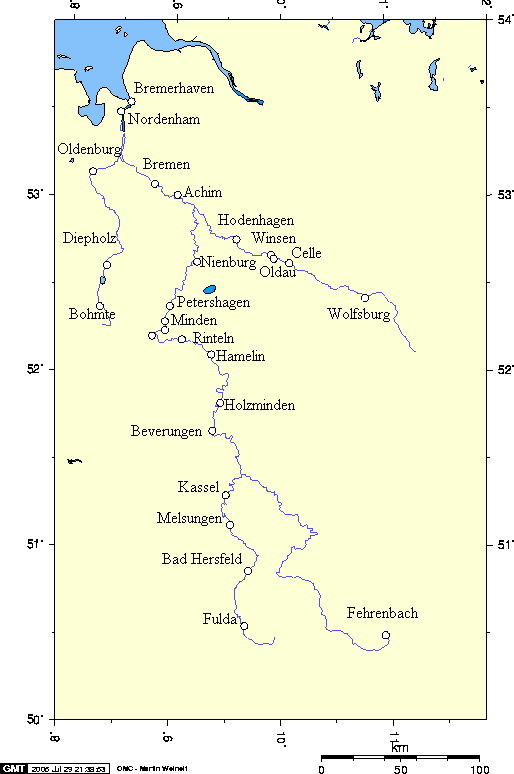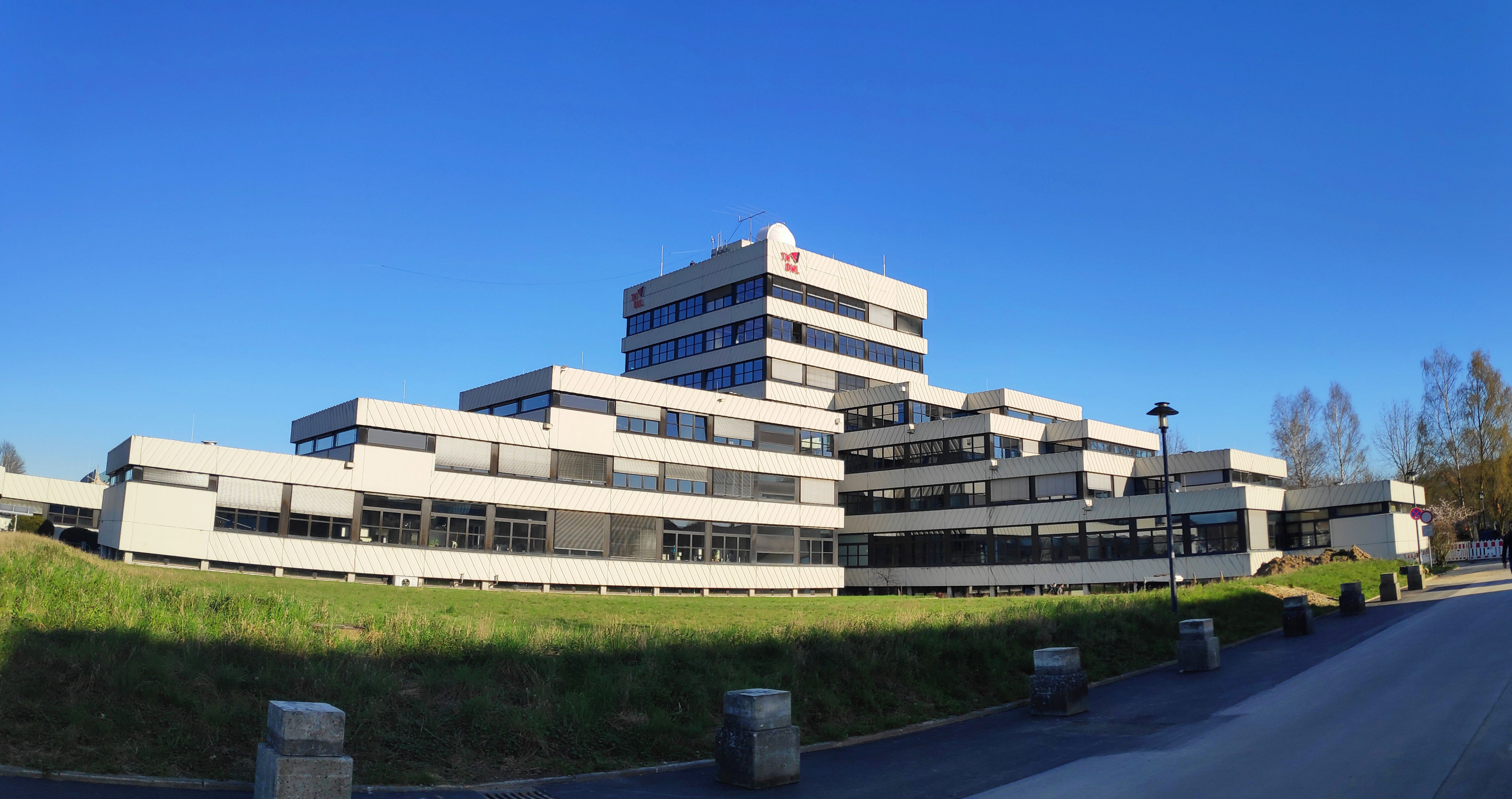|
Weserrenaissance
Weser Renaissance is a form of Northern Renaissance architectural style that is found in the area around the River Weser in central Germany and which has been well preserved in the towns and cities of the region. Background Between the start of the Reformation and the Thirty Years War the Weser region experienced a construction boom, in which the Weser, playing a significant role in the communication of both trade and ideas, merely defined the north–south extent of a cultural region that stretched westwards to the city of Osnabrück and eastwards as far as Wolfsburg. Castles, manor houses, town halls, residential dwellings and religious buildings of the Renaissance period have been preserved in unusually high density, because the economy of the region recovered only slowly from the consequences of the Thirty Years War and the means were not available for a baroque transformation such as that which occurred to a degree in South Germany. Origin of the term The term, coine ... [...More Info...] [...Related Items...] OR: [Wikipedia] [Google] [Baidu] |
Minden
Minden () is a middle-sized town in the very north-east of North Rhine-Westphalia, Germany, the greatest town between Bielefeld and Hanover. It is the capital of the district (''Kreis'') of Minden-Lübbecke, which is part of the region of Detmold. The town extends along both sides of the River Weser, and is crossed by the Mittelland Canal, which is passing the river on the Minden Aqueduct. In the 1,200 years longing time of written history, Minden had functions as diocesan town from 800 AD to the Peace of Westphalia in 1648, as capital of the Prince-Bishopric of Minden as imperial territory since the 12th century, afterwards as capital of the Prussian territory of Minden-Ravensberg until the end of the Holy Roman Empire in 1806, and as capital of the East-Westphalian region from the Congress of Vienna until 1947. Furthermore Minden has been of great military importance with fortifications from the 15th to the late 19th century, and is yet place of a garrison. Minden is locati ... [...More Info...] [...Related Items...] OR: [Wikipedia] [Google] [Baidu] |
Celle Castle
Celle Castle (german: Schloss Celle) or, less commonly, Celle Palace, in the German town of Celle in Lower Saxony, was one of the residences of the House of Brunswick-Lüneburg. This quadrangular building is the largest castle in the southern Lüneburg Heath region. History Celle Castle is based on a fortified wall tower (''Wehrturm'') with the character of a water castle, that guarded a ford over the River Aller. This first fortification, called ''Kellu'', was built by a Brunonen count around 980 AD. Another forerunner of the castle, which may have been an extension of the wall tower, was founded in 1292 by Otto the Strict. The cellar vault and the lower stories of the watch tower have survived to the present day. Its ruins lie underneath the castle theatre. Around 1315 the actual ''Castrum Celle'' was first recorded. As a consequence of the War of the Lüneburg Succession, in 1378 the Dukes of Brunswick-Lüneburg moved their ''Residenz'' from Lüneburg to Celle and began ... [...More Info...] [...Related Items...] OR: [Wikipedia] [Google] [Baidu] |
Bossage
Bossage is uncut stone that is laid in place in a building, projecting outward from the building, to later be carved into decorative moldings, capitals, arms, etc. Bossages are also rustic work, consisting of stones which seem to advance beyond the surface of the building, by reason of indentures, or channels left in the joinings; used chiefly in the corners of buildings, and called rustic quoins. The cavity or indenture may be round, square, chamfered, beveled, diamond-shaped, or enclosed with a cavetto or listel. See also * Boss (architecture) * Glossary of architecture This page is a glossary of architecture. A B C image:Porch of Maidens.jpg, The C ... * Bossage (architecture) in France References Architectural elements {{architecturalelement-stub ... [...More Info...] [...Related Items...] OR: [Wikipedia] [Google] [Baidu] |
Einbeck
Einbeck (; Eastphalian: ''Aimbeck'') is a town in the district Northeim, in southern Lower Saxony, Germany, on the German Timber-Frame Road. History Prehistory The area of the current city of Einbeck is inhabited since prehistoric times. Various artifacts have been unearthed in the city of Einbeck itself and in the little villages and lost villages around it over the years. They date back to the Paleolithic Era. Medieval period In the Early Middle Ages a number of villages existed along the river Ilme in the middle Leine valley before Einbeck was founded. On January 1, 1158 Einbeck was first mentioned in a deed of Friedrich Barbarossa, which mentioned ''… in loco qui Einbike vocatur …''. and related to a transfer of an estate in the 11th century. Count Udo of Katlenburg owned an estate on the bank of a brook, the Krummes Wasser (crooked water). His grandson founded the stift Sankt Alexandri, that subsequently developed into an important sanctuary. On the other side of th ... [...More Info...] [...Related Items...] OR: [Wikipedia] [Google] [Baidu] |
Höxter
Höxter () is a town in eastern North Rhine-Westphalia, Germany on the left bank of the river Weser, 52 km north of Kassel in the centre of the Weser Uplands. The main town's population is around 15,000, and with outlying centres, about 30,000. It is the seat of the Höxter district. Historical place names of Höxter are Hoxer and Huxaria. Geography Subdivisions As part of North Rhine-Westphalia's municipal reforms, the collective municipality of Höxter came into being on 1 January 1970, formed out of the eleven communities of the former ''Amt'' of Höxter-Land, the main town, and the community of Bruchhausen from the former ''Amt'' of Beverungen. The communities in question voluntarily merged to pool their resources and bring about a unified administration. These constituent communities are: *Albaxen *Bosseborn * Bödexen *Brenkhausen *Bruchhausen *Fürstenau *Godelheim *Lüchtringen *Lütmarsen *Ottbergen *Ovenhausen *Stahle History Höxter (Latin Huxaria) in the t ... [...More Info...] [...Related Items...] OR: [Wikipedia] [Google] [Baidu] |
Hamelin
Hamelin ( ; german: Hameln ) is a town on the river Weser in Lower Saxony, Germany. It is the capital of the district of Hamelin-Pyrmont and has a population of roughly 57,000. Hamelin is best known for the tale of the Pied Piper of Hamelin. History Hamelin started with a monastery, which was founded as early as 851 AD. A village grew in the neighbourhood and had become a town by the 12th century. The incident with the "Pied Piper" (see below) is said to have happened in 1284 and may be based on a true event, although somewhat different from the tale. In the 15th and 16th centuries Hamelin was a minor member of the Hanseatic League. In June 1634, during the Thirty Years' War, Lothar Dietrich, Freiherr of Bönninghausen, a General with the Imperial Army, lost the Battle of Oldendorf to the Swedish General Kniphausen, after Hamelin had been besieged by the Swedish army. The era of the town's greatest prosperity began in 1664, when Hamelin became a fortified border town of the ... [...More Info...] [...Related Items...] OR: [Wikipedia] [Google] [Baidu] |
Nienburg/Weser
Nienburg (, official name: ''Nienburg/Weser'') (Low German: ''Nienborg'', ''Neenborg'' or ''Negenborg'') is a town and capital of the district Nienburg, in Lower Saxony, Germany. Geography Situated on the scenic German Timber-Frame Road, Nienburg lies on the river Weser, approximately southeast of Bremen, and northwest of Hanover. Nienburg is the largest town in the Middle Weser Region. Demography (as of Dec. 31st) Structure Nienburg, including quarters * Erichshagen * Holtorf * Langendamm * Schäferhof/Kattriede * Nordertor * Leintor * Lehmwandlung * Alpheide History The major reason for the emergence and development of Nienburg into the largest city in the Middle Weser region was its location at a convenient ford in the Weser River, leading to multiple trade routes radiating from the location. As early as 1025 the location was referred to as ''Negenborg'', i.e. New Castle. In 1215 it began to be referred to as a city, a ''civitas'', when Count Henry I of Hoya began ... [...More Info...] [...Related Items...] OR: [Wikipedia] [Google] [Baidu] |
Lemgo
Lemgo (; nds, Lemge, Lemje) is a small university town in the Lippe district of North Rhine-Westphalia, Germany. It is situated between the Teutoburg Forest and the Weser Uplands, 25 km east of Bielefeld and 70 km west of Hannover. The old Hanseatic town Lemgo has a population of c. 41,000 (2017) and belongs to the OWL region, which is one of the most important cluster regions for mechanical engineering and industrial electronics in Germany. In 2017 the German Internet portal reisereporter.de placed Lemgo among the most beautiful ten half-timbered towns in Germany. History It was founded in the 12th century by Bernard II, Lord of Lippe at the crossroad of two merchant routes. Lemgo was a member of the Hanseatic League, a medieval trading association of free or autonomous cities in several northern European countries such as the Netherlands, Germany and Poland. During the Reformation the city of Lemgo adopted Lutheranism in 1522, whereas otherwise in Lippe, its sprea ... [...More Info...] [...Related Items...] OR: [Wikipedia] [Google] [Baidu] |
Celle
Celle () is a town and capital of the district of Celle, in Lower Saxony, Germany. The town is situated on the banks of the river Aller, a tributary of the Weser, and has a population of about 71,000. Celle is the southern gateway to the Lüneburg Heath, has a castle ('' Schloss Celle'') built in the Renaissance and Baroque style and a picturesque old town centre (the ''Altstadt'') with over 400 timber-framed houses, making Celle one of the most remarkable members of the German Timber-Frame Road. From 1378 to 1705, Celle was the official residence of the Lüneburg branch of the dukes of Brunswick-Lüneburg ( House of Welf) who had been banished from their original ducal seat by its townsfolk. Geography The town of Celle lies in the glacial valley of the Aller, about northeast of Hanover, northwest of Brunswick and south of Hamburg. With 71,000 inhabitants it is, next to Lüneburg, the largest Lower Saxon town between Hanover and Hamburg. Expansion The town covers ... [...More Info...] [...Related Items...] OR: [Wikipedia] [Google] [Baidu] |
Lemgo - Marktplatz Mit Rathaus
Lemgo (; nds, Lemge, Lemje) is a small university town in the Lippe district of North Rhine-Westphalia, Germany. It is situated between the Teutoburg Forest and the Weser Uplands, 25 km east of Bielefeld and 70 km west of Hannover. The old Hanseatic town Lemgo has a population of c. 41,000 (2017) and belongs to the OWL region, which is one of the most important cluster regions for mechanical engineering and industrial electronics in Germany. In 2017 the German Internet portal reisereporter.de placed Lemgo among the most beautiful ten half-timbered towns in Germany. History It was founded in the 12th century by Bernard II, Lord of Lippe at the crossroad of two merchant routes. Lemgo was a member of the Hanseatic League, a medieval trading association of free or autonomous cities in several northern European countries such as the Netherlands, Germany and Poland. During the Reformation the city of Lemgo adopted Lutheranism in 1522, whereas otherwise in Lippe, its sprea ... [...More Info...] [...Related Items...] OR: [Wikipedia] [Google] [Baidu] |








